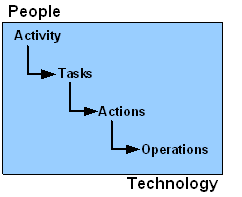Balanced Scorecard
Balanced Scorecard is a system that aligns specific business activities to an organization’s vision and strategy. [1] Using a scorecard helps organizations balance their strategic objectives across four perspectives:
- Financial—The Financial Perspective examines the contribution of an organization’s strategy to the bottom line. It represents the strategic objectives of an organization in terms of increasing revenue and reducing cost.
- Customer—The Customer Perspective focuses on customers’ satisfaction, which contributes to the organization’s revenue. It represents the value an organization delivers to customers, the value proposition, and the resulting customer satisfaction.
- Internal Business Processes—The Internal Process Perspective is concerned with requirements for products and services that deliver the customer value proposition. It focuses on activities and key processes that are necessary for an organization to excel at providing the value customers expect.
- Learning and Growth—The Learning and Growth Perspective focuses on the internal skills and capabilities an organization requires to support value-creating internal processes. This perspective includes employee training, the development of corporate cultural attitudes relating to both individual and corporate self-improvement, and the technological tools that support these activities.
By understanding the basics of Balanced Scorecard, you can marry your user experience activities to your organization’s overall strategy. One popular user experience design process that can help you do that is activity-centered design.
Activity-Centered Design
Solutions work best when we develop them with a deep understanding of the activities we must perform to meet all of these needs. This approach is called activity-centered design (ACD). [2] ACD puts the activities in which organizations engage at the center of the experience design process. It is essential to put your design solutions into the context of the market problems they solve, the business objectives they support, and the customer and user needs they meet.
In ACD, an activity is a coordinated, integrated set of tasks. Activities comprise tasks, which themselves comprise actions, and actions are made up of operations, as shown in Figure 1.

The User Experience Balanced Scorecard
With the Balanced Scorecard system, an organization can align and manage its key corporate objectives. The User Experience Balanced Scorecard maps the user experience process and skills to customer satisfaction and financial growth. At a high level, a User Experience Balanced Scorecard might look something like that shown in Figure 2.
| PERSPECTIVE | USER EXPERIENCE STRATEGY |
|---|---|
FINANCIAL |
Increase revenue. | Reduce costs. |
CUSTOMER |
Increase conversions, retention, and wallet share. | Reduce cycle time, training, and support. |
PROCESS |
Create an attractive, friendly, and easy customer experience through research, iterative design, validation, and usability testing. |
EMPLOYEE |
User Researcher | Information Architect | Visual Designer | Interaction Designer | Usability Engineer |
Notice that the customer objectives of increasing conversions, retention, and wallet share map to increasing revenue and reduced cycle time; reducing training and support costs maps to the financial objectives of reducing costs. Depending on an organization’s overall strategy, you could break down the User Experience Balanced Scorecard like that shown in Figure 3.
| PERSPECTIVE | USER EXPERIENCE STRATEGY | ||
|---|---|---|---|
FINANCIAL |
Enable revenue growth. |
Improve customer wallet share. |
Increase productivity. |
CUSTOMER |
Establish product leadership and innovate through research and analysis of target-market |
Improve customer intimacy through iterative design reviews with target customers. |
Improve quality of user experience. |
PROCESS |
Research and analysis |
Interactive prototyping |
Usability evaluation |
EMPLOYEE |
Research Analyst |
Information Architect, Visual Designer, and Interaction Designer |
Usability Engineer |

